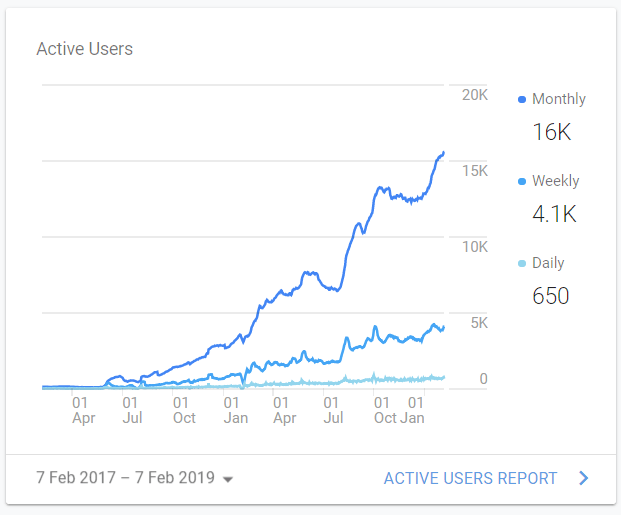There is a good reason for hope, for those who look for a happy ending to the revolution of population genomics that is quickly turning into an involution led by beliefs and personal interests. This blog is apparently one of the the most read sites on Indo-European peoples, if not the most read one, and now on Uralic peoples, too.
I’ve been checking the analytics of our sites, and judging by the numbers of the English blog, Indo-European.eu (without the other languages) is quickly turning into the most visited one from Academia Prisca‘s sites on Indo-European languages, beyond Indo-European.info (and its parent sites in other languages), which host many popular files for download.
If we take into account file downloads (like images or PDFs), and not only what Google Analytics can record, Indo-European.eu has not more users than all other websites of Academia Prisca, but at this pace it will soon reach half the total visits, possibly before the end of 2019.
Overall, we have evolved from some 10,000 users/year in 2006 to ~300,000 active users/year and >1,000,000 page+file views/year in 2018 (impossible to say exactly without spending too much time on this task). Nothing out of the ordinary, I guess, and obviously numbers are not a quality index, but rather a hint at increasing popularity of the subject and of our work.
NOTE. The mean reading time is ~2:40 m, which I guess fits the length of most posts, and most visitors read a mean of ~2+ pages before leaving, with increasing reader fidelity over time.

The most read posts of 2018, now that we can compare those from the last quarter, are as follows:
- – The series on the Corded Ware-Uralic theory, with a marked increase in readers, especially with the last three posts:
- Finno-Permic and the expansion of N-L392/Siberian ancestry,
- “Siberian ancestry” and Ugric-Samoyedic expansions, and
- Haplogroups R1a and N in Finno-Ugric and Samoyedic
- Haplogroup is not language, but R1b-L23 expansion was associated with Proto-Indo-Europeans
- The history of the simplistic ‘haplogroup R1a — Indo-European’ association
- On the origin of haplogroup R1b-L51 in late Repin / early Yamna settlers
- On the origin and spread of haplogroup R1a-Z645 from eastern Europe
- The Caucasus a genetic and cultural barrier; Yamna dominated by R1b-M269; Yamna settlers in Hungary cluster with Yamna
- Something is very wrong with models based on the so-called ‘Yamnaya admixture’ – and archaeologists are catching up (II)
- Olalde et al. and Mathieson et al. (Nature 2018): R1b-L23 dominates Bell Beaker and Yamna, R1a-M417 resurges in East-Central Europe during the Bronze Age
- Early Indo-Iranian formed mainly by R1b-Z2103 and R1a-Z93, Corded Ware out of Late PIE-speaking migrations
- “Steppe ancestry” step by step: Khvalynsk, Sredni Stog, Repin, Yamna, Corded Ware
NOTE. Of course, the most recent posts are the most visited ones right now, but that’s because of the constant increase in the number of visitors.
I think it is obvious what the greatest interest of readers has been in the past two years. You can see the pattern by looking at the most popular posts of 2017, when the blog took off again:
- Germanic–Balto-Slavic and Satem (‘Indo-Slavonic’) dialect revisionism by amateur geneticists, or why R1a lineages *must* have spoken Proto-Indo-European
- The renewed ‘Kurgan model’ of Kristian Kristiansen and the Danish school: “The Indo-European Corded Ware Theory”
- The new “Indo-European Corded Ware Theory” of David Anthony
- Correlation does not mean causation: the damage of the ‘Yamnaya ancestral component’, and the ‘Future American’ hypothesis
- The Aryan migration debate, the Out of India models, and the modern “indigenous Indo-Aryan” sectarianism
The most likely reason for the radical increase in this blog’s readership is very simple, then: people want to know what is really happening with the research on ancestral Indo-Europeans and Uralians, and other blogs and forums are not keeping up with that demand, being content with repeating the same ideas again and again (R1a-CWC-IE, R1b-BBC-Vasconic, and N-Comb Ware-Uralic), despite the growing contradictions. As you can imagine, once you have seen the Yamna -> Bell Beaker migration model of North-West Indo-European, with Corded Ware obviously representing Uralic, you can’t unsee it.
The online bullying, personal attacks, and similar childish attempts to silence those who want to talk about this theory elsewhere (while fringe theories like R1a/CHG-OIT, R1b-Vasconic, or the Anatolian/Armenian-CHG hypotheses, to name just a few, are openly discussed) has had, as could be expected, the opposite effect to what was intended. I guess you can say this blog and our projects have profited from the first relevant Streisand effect of population genomics, big time.
If this trend continues this year (and other bloggers’ or forum users’ faith in miracles is not likely to change), I suppose that after the Yamna Hungary samples are published (with the expected results) this blog is going to be the most read in 2020 by a great margin… I can only infer that this tension is also helping raise the interest in (and politicization of) the question, hence probably the overall number of active users and their participation in other blogs and forums is going to increase everywhere in 2019, too, as this debate becomes more and more heated.
So, what I infer from the most popular posts and the numbers is that people want criticism and controversy, and if you want blood you’ve got it. Here it is, my latest addition to the successful series criticizing the “Corded Ware/R1a–Indo-European” pet theories, a post I wrote two-three months ago, slightly updated with the newest comedy, and a sure success for 2019 (already added to the static pages of the menu):
The “Indo-European Corded Ware theory” doesn’t hold water
This is how I feel when I see spikes in visits with more and more returning users linked to my controversial posts ;-)
Are you not entertained?! Are you not entertained?! Is this not why you are here?!